一组中国读者翻译了此文并发布在知乎网站
https://zhuanlan.zhihu.com/p/61066127
Scientists in China pretending to work on cleaning up the environment of industrial pollution and radioactive waste have instead engaged in massive data fabrication, while running a citation cartel. Some of the data was allegedly generated at the Shanghai Synchrotron Radiation Facility, yet the spectra were reused, photoshopped and fabricated in different contexts, which makes one wonder if the authors ever actually accessed any synchrotron facilities for their numerous research projects. The central figure here is the 37 year old physicist Yubing Sun. This shooting star of environmental nanotechnology rose to a professorship at the Institute of Plasma Physics of the Chinese Academy of Sciences in Hefei, while boasting over 50 papers and an h-index of 32. It is apparently all built on fraud, and Sun belongs to a bigger gang which polluted science and society with fabricated data and rigged citations, all for own career advancement. As in a similar case, tracks were covered by avoiding shared authorships. Sun and his friends felt safe in inventing and sharing fake data and citing each other excessively, their academic careers flourished, while new generations of young cheaters are being trained by Professor Sun and his colleagues.
The following is a guest post by Smut Clyde, presenting his and TigerBB8‘s joint investigation into the Sun et al affair, spanning 22 papers from 2012 till 2018 in respectable journals of ACS and RSC.
The Subtleties a Spectrograph Would Miss, by Smut Clyde
The Brocken Spectre is a phenomenon seen from a mountain peak, looking down on clouds or fog with the sun behind one. “Brokenspectra” is a term I made up just now for unnatural wavelength functions – X-ray or IR or Raman spectra (and including X-ray diffraction patterns as honorary members of the club) – stitched together from spare parts, preferably in a laboratory in a Carpathian castle while angry peasants gather at the gates with pitchforks and torches.
Here is one to whet your appetite. I think it is some kind of mutant bar-code containing a hidden message.
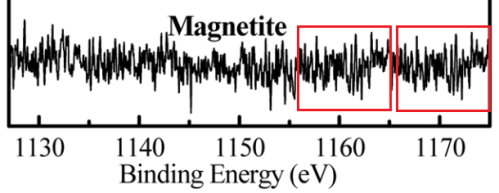
And another. It is remarkably similar to my EKG after the second double-shot espresso of the morning.
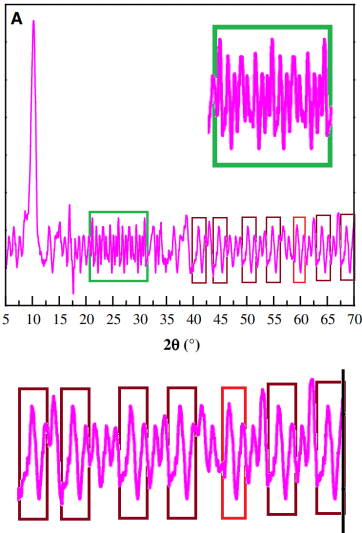
Leonid’s readers will be disappointed by the absence of manipulated protein Western Blots from today’s post [Please donate below to lodge a formal complaint. -LS]. Instead there are electron-microscopy images of a protean nature, shifting their identities on every appearance; and Brokenspectra, including the first sightings from the high-end extreme of EXAFS (Extended X-Ray Absorption Fine Structure), which may serve as some consolation. Also versatile scholars in the Renaissance mould of Aldrovandi or Athanasius Kircher, breaking out from the narrow confines of their nominal specialty to publish in physical chemistry; and there are unusual patterns of citation. The central characters are Yubing Sun , a prolific and well-funded researcher at Hefei Institute of Physical Sciences (Institute of Plasma Physics) of the Chinese Academy of Sciences and North China Electrical Power University (NCEPU); and his frequent co-author, Xiangke Wang – Sun’s boss at NCEPU. But we should begin at the end: with…
[1] Min Pan , Guangxue Wu , Chang Liu , Xinxin Lin , Xiaoming Huang
Enhanced Adsorption of Zn(II) onto Graphene Oxides Investigated Using Batch and Modeling Techniques
MDPI Nanomaterials (2018) doi: 10.3390/nano8100806
 This excursion into advanced materials science is atypical for the lead author Min Pan, of Xiamen University of Technology, whose career centres on the treatment of sewage and slaughterhouse wastewater. The paper raises some concerns, as featured in a PubPeer thread. In particular, Figure 1 sets out to characterise the Graphene Oxide (GO) in various ways. But stuttering in the XRD contained in panel 1(E) hints at some heinous malfunction in the diffraction equipment. Figure 1(B) is a TEM (Transmission Electron Microscope) image of the experimental GO, but a section of it had previously been enlarged and slightly rotated [at right] to illustrate GO3, in:
This excursion into advanced materials science is atypical for the lead author Min Pan, of Xiamen University of Technology, whose career centres on the treatment of sewage and slaughterhouse wastewater. The paper raises some concerns, as featured in a PubPeer thread. In particular, Figure 1 sets out to characterise the Graphene Oxide (GO) in various ways. But stuttering in the XRD contained in panel 1(E) hints at some heinous malfunction in the diffraction equipment. Figure 1(B) is a TEM (Transmission Electron Microscope) image of the experimental GO, but a section of it had previously been enlarged and slightly rotated [at right] to illustrate GO3, in:
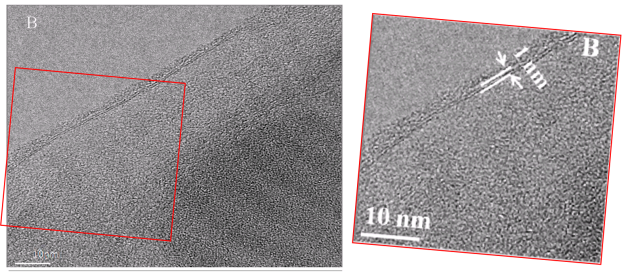
[2]. Yubing Sun , Shubin Yang , Congcong Ding , Zhongxiu Jin , Wencai Cheng
Tuning the chemistry of graphene oxides by a sonochemical approach: application of adsorption properties
RSC Advances (2015) doi: 10.1039/c5ra02021b
You will have noticed the two papers share overlapping research data but no overlapping authors. But there is a clue: last author of [1] Huang and first author of [2] Sun studied for a MSc degree at the School of Resources and Environmental Engineering at Hefei University of Technology at around same time, 2006-2009 and 2004-2007, respectively. Sun moved on doing a PhD, Huang lacking such a degree is employed as “technician” at the School of Environmental Science and Engineering in Xiamen, since 2018 as “senior technician”. His humble first author Pan on the other hand, has a PhD degree and is employed as lecturer on associate professor track. A peculiar academic relationship between Mr Huang and Dr Pan.
The SEM (Scanning Electron Microscope) image of the experimental GO had previously illustrated “HOOC-GOs” when it appeared in Fig 1(B) [right] of :

[3] Yubing Sun , Shubin Yang , Yue Chen , Congcong Ding , Wencai Cheng , Xiangke Wang
Adsorption and desorption of U(VI) on functionalized graphene oxides: a combined experimental and theoretical study
Environmental Science & Technology (2015) doi: 10.1021/es505590j
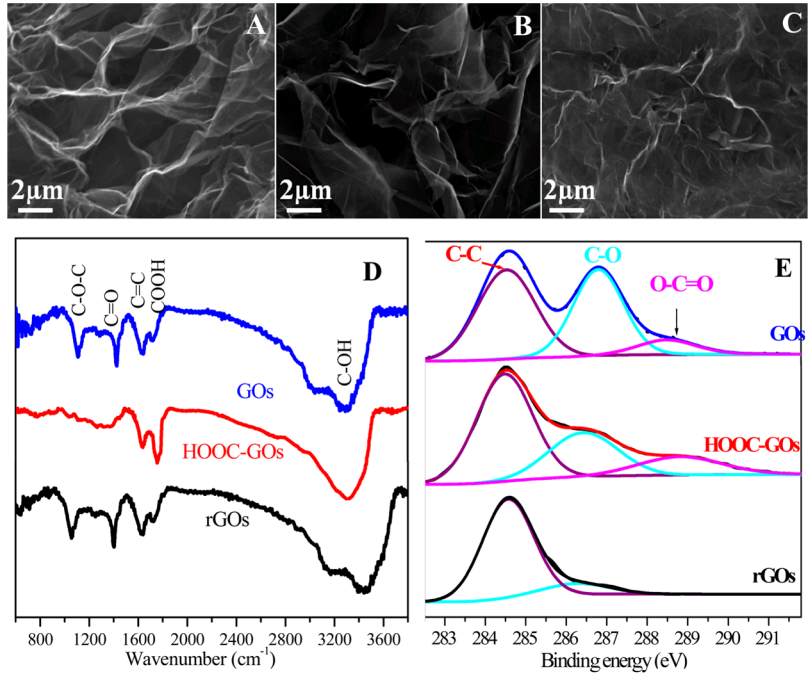
In fact Fig 1 of [3] has undergone some remarkable migrations. For convenient referral I show it above. As noted, Panel 1(B) is a SEM of “HOOC-GOs“. Except when it illustrates “sulfonated graphene oxide” (GO-OSO3H):
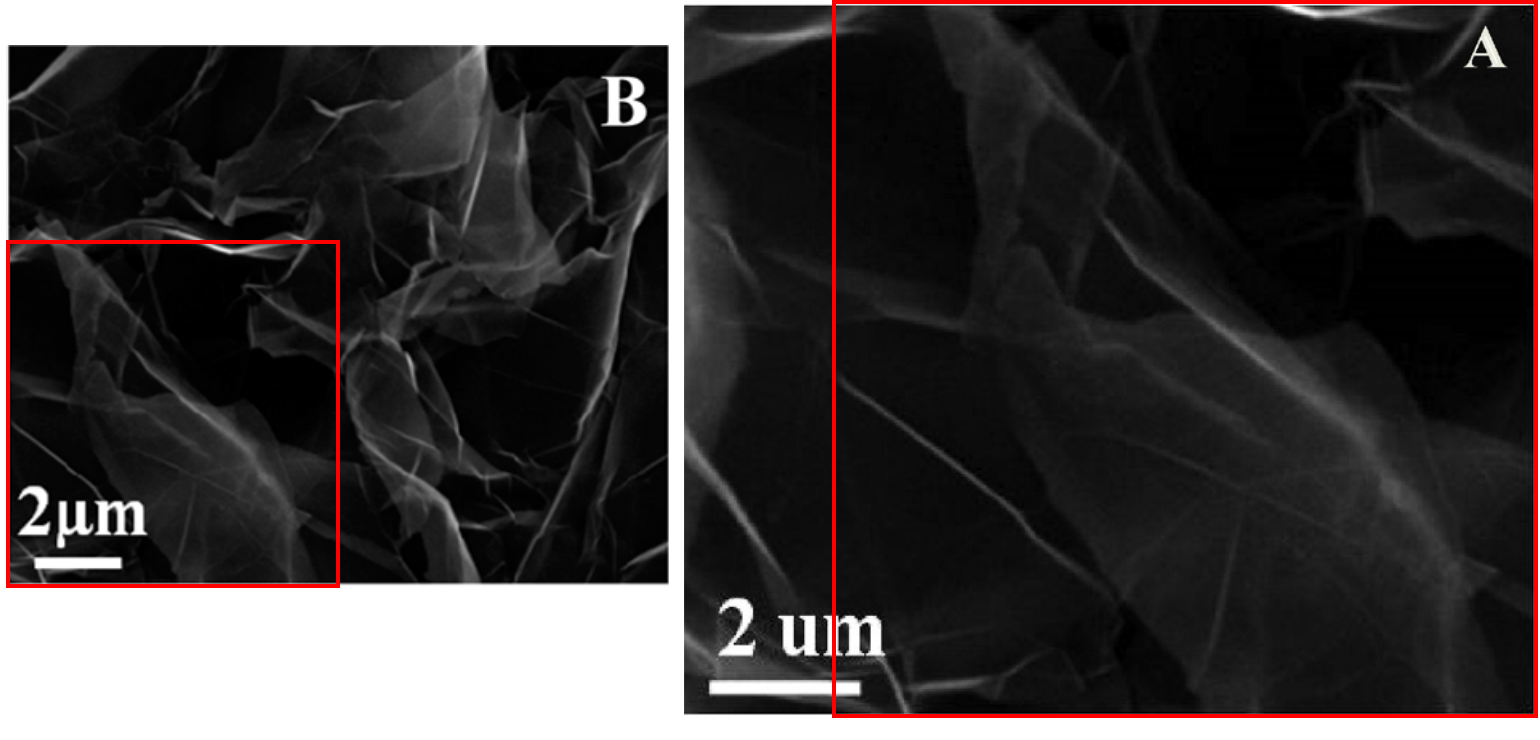
Note that one image is not simply an enlarged detail of the other: they overlap, each with its own unique segment, suggesting that two sets of authors cut down a single larger Ur-version, in different ways. Note also that this is now a different paper: we have set Min Pan’s oeuvre aside for the moment, and turned to Ting Yao, of the Air Force Logistics College in Xuzhou. Yao has published on aspects of aviation oil and remediation of contaminated environments. But at some point she gained access to a supply of rare-earth elements and wrote:
[4] Ting Yao , Yunpeng Xiao , Xiaowen Wu , Changying Guo , Yuanli Zhao , Xi Chen
Adsorption of Eu(III) on sulfonated graphene oxide: Combined macroscopic and modeling techniques
Journal of Molecular Liquids (2016) doi: 10.1016/j.molliq.2015.11.030
Figure 1 of [4] characterises the GO-OSO3H in several ways, including an XPS spectrum [1D, right] which is indebted to the carboxylated GO of [3].
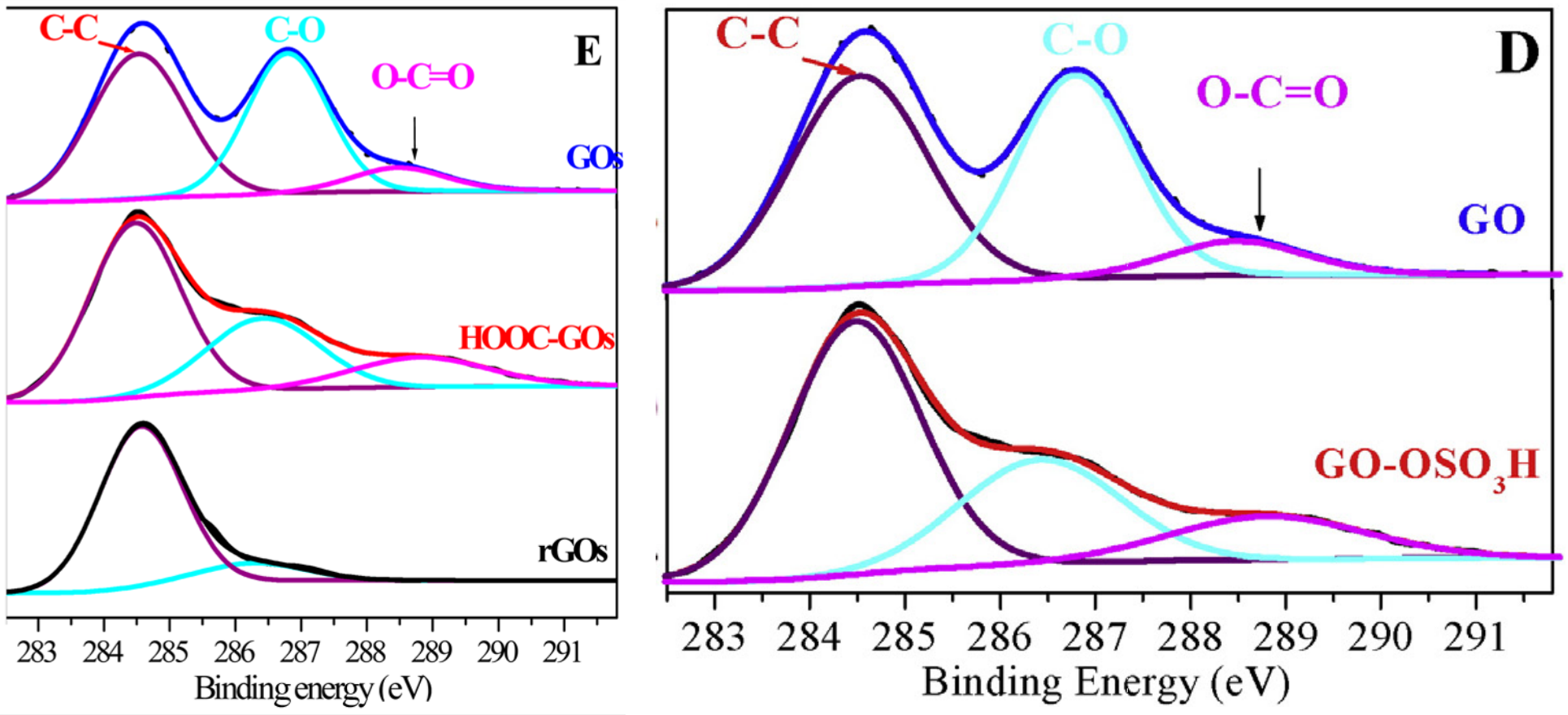
Don’t fear that the other panels of Figure 1 from [3] have been neglected. Panel 1(C) is postponed until [20]. As for 1(A), we find it illustrating an application of GO, in Figure 1 of paper [5] from Min Pan:
[5] Xiaoming Huang , Min Pan
The highly efficient adsorption of Pb(II) on graphene oxides: A process combined by batch experiments and modeling techniques
Journal of Molecular Liquids (2016) doi: 10.1016/j.molliq.2015.12.061
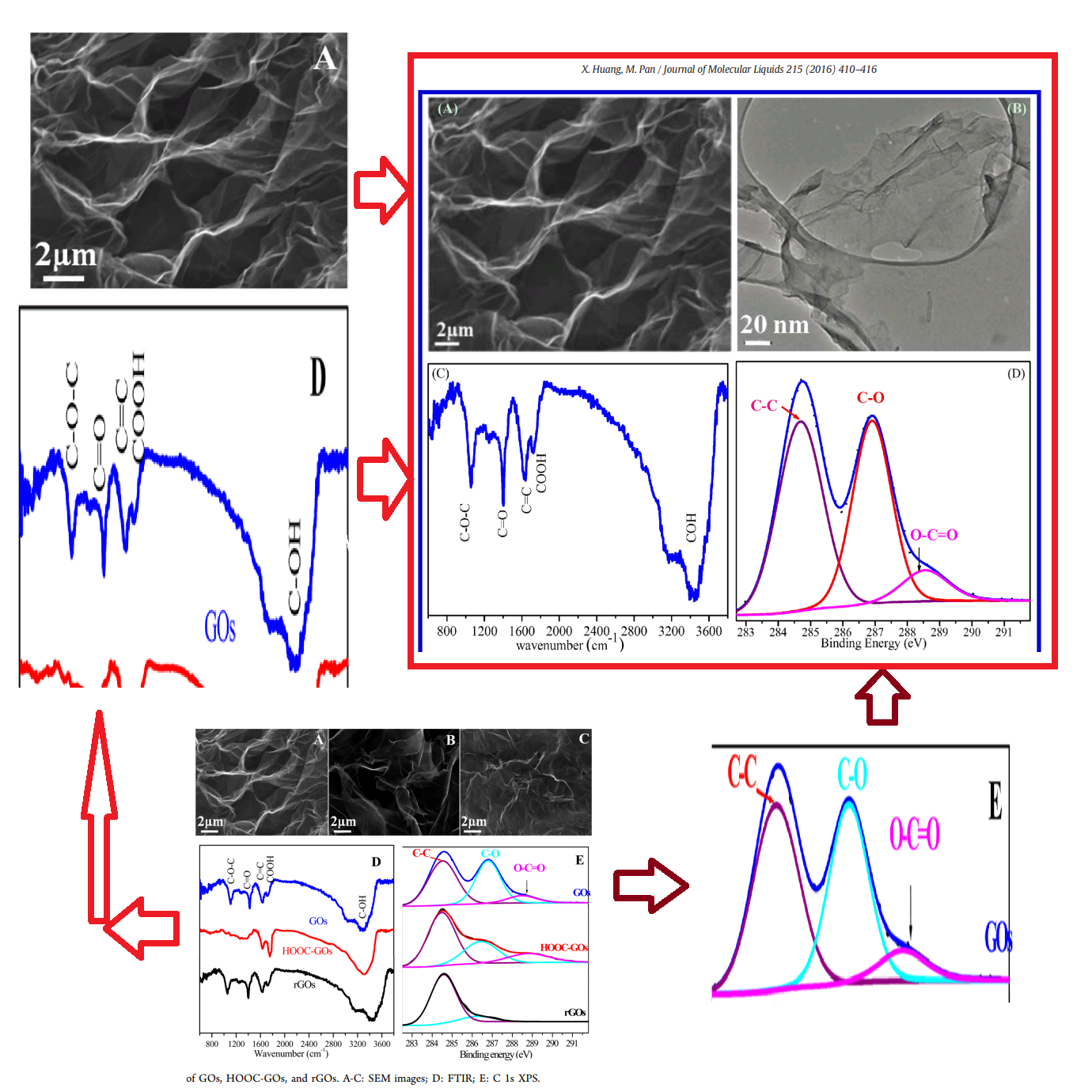
But we have not finished with Ting Yao’s work. At left below is Figure 1 B, a FTIR spectrum characterising B subtilis, from
[6] Ting Yao, Xiaowen Wu, Xi Chen, Yunpeng Xiao, Yongguo Zhang, Yuanli Zhao, Fengbo Li
Biosorption of Eu(III) and U(VI) on Bacillus subtilis : Macroscopic and modeling investigation
Journal of Molecular Liquids (2016) doi: 10.1016/j.molliq.2016.01.101
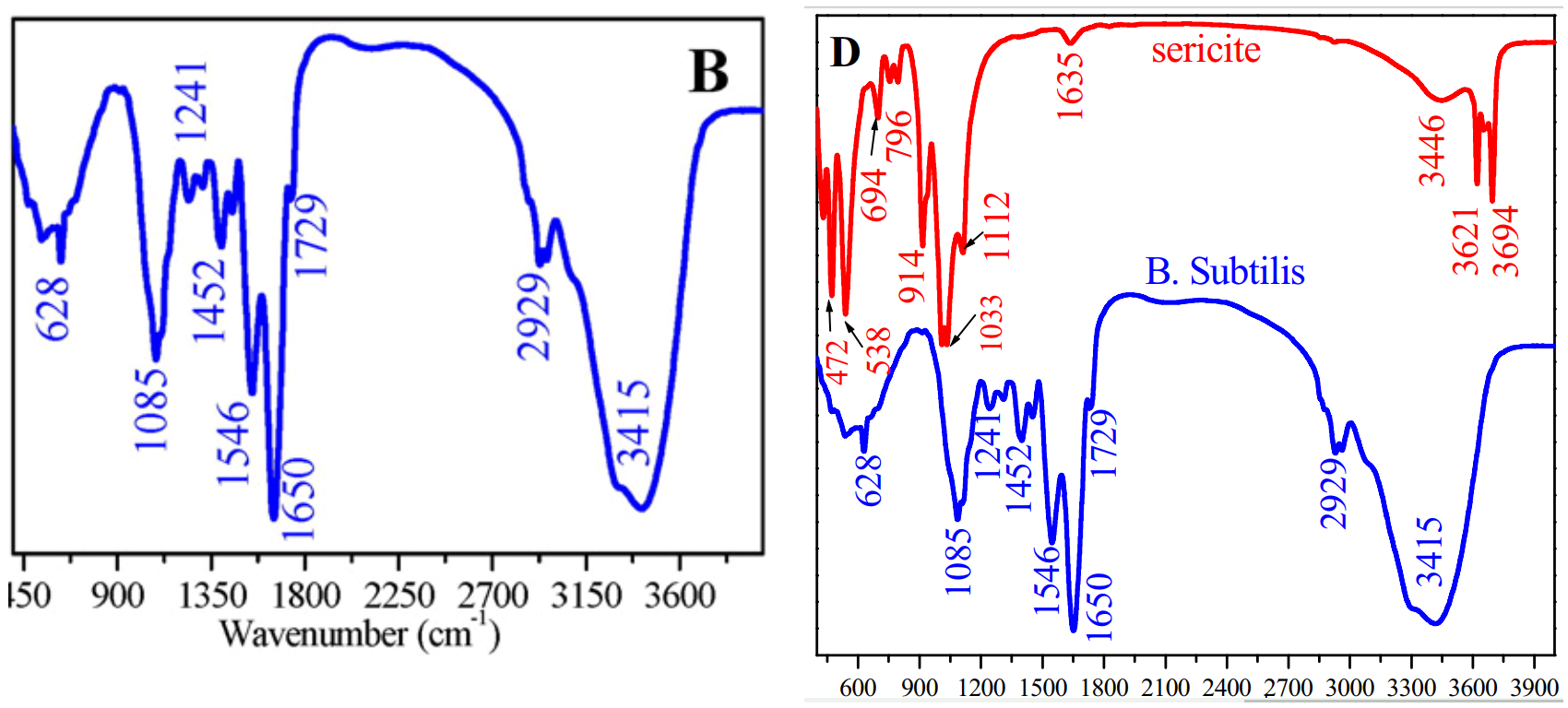
It is shared at right, in common with the lower FTIR spectrum of Fig 1D in :
[7] Yubing Sun , Rui Zhang , Congcong Ding , Xiangxue Wang , Wencai Cheng , Changlun Chen , Xiangke Wang
Adsorption of U(VI) on sericite in the presence of Bacillus subtilis: A combined batch, EXAFS and modeling techniques
Geochimica et Cosmochimica Acta (2016) doi: 10.1016/j.gca.2016.02.012
Now the final and corresponding author of [6] was Fengbo Li, a new arrival in the dramatis personae. His scholarly endeavours at Huangshan University have focused on applications of a soil fungus, Paecilomyces catenlannulatus – in particular, its potential for sequestering and bioabsorbing heavy metals. There is a recurring theme here, of dealing with environmental contaminants of the breathtakingly-toxic and sometimes radioactive variety, reflecting the downside of China’s industrial transformation. Anyway, Li serves as a link to a third cluster of researchers with their own pair of papers.
[8] Fengbo Li , Xiaoyu Li , Pu Cui
Adsorption of U(VI) on magnetic iron oxide/ Paecilomyces catenlannulatus composites
Journal of Molecular Liquids (2018) doi: 10.1016/j.molliq.2017.12.136
Figure 1 is what catches the eye, for the “MIO/B composites” shown there are reminiscent of the “carbon nanofibers” depicted in another Figure 1 from a different paper:
[9] Yubing Sun , Zhen-Yu Wu , Xiangxue Wang , Congcong Ding , Wencai Cheng , Shu-Hong Yu , Xiangke Wang
Macroscopic and Microscopic Investigation of U(VI) and Eu(III) Adsorption on Carbonaceous Nanofibers
Environmental Science & Technology (2016) doi: 10.1021/acs.est.6b00058

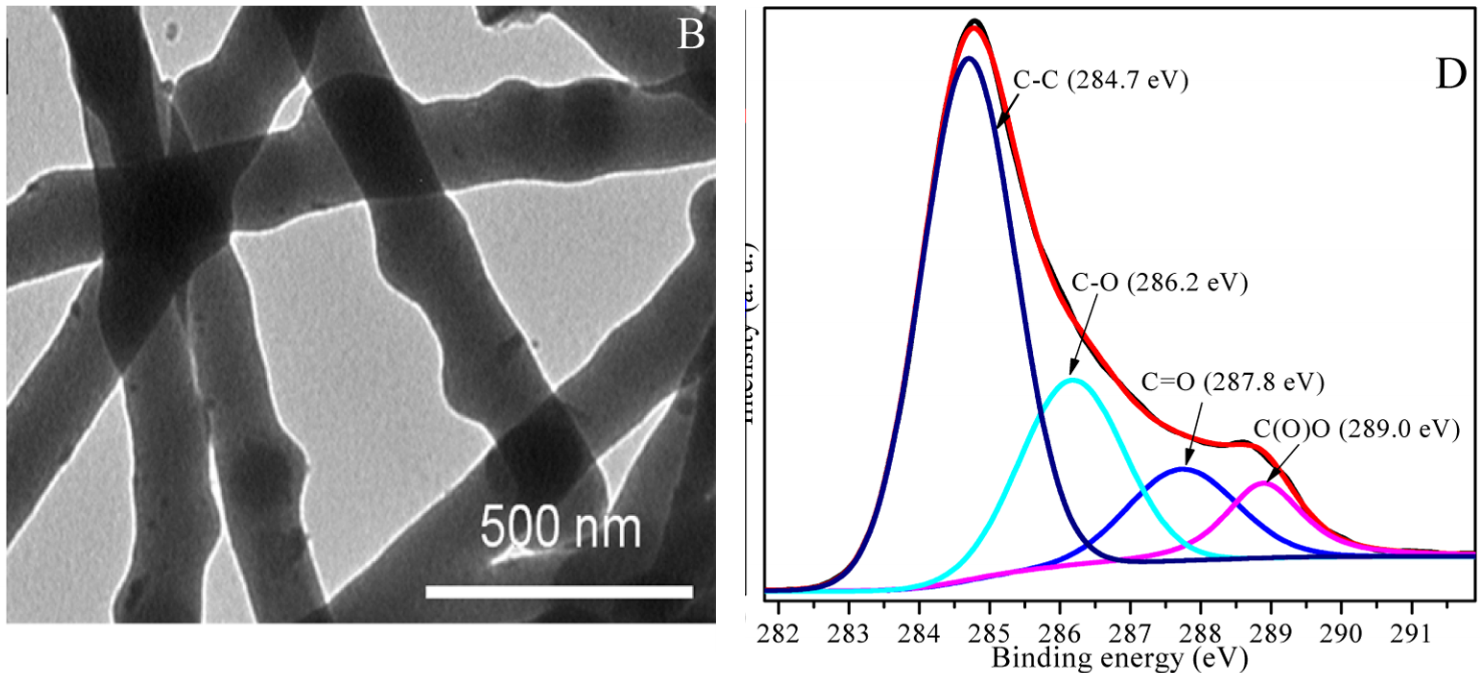
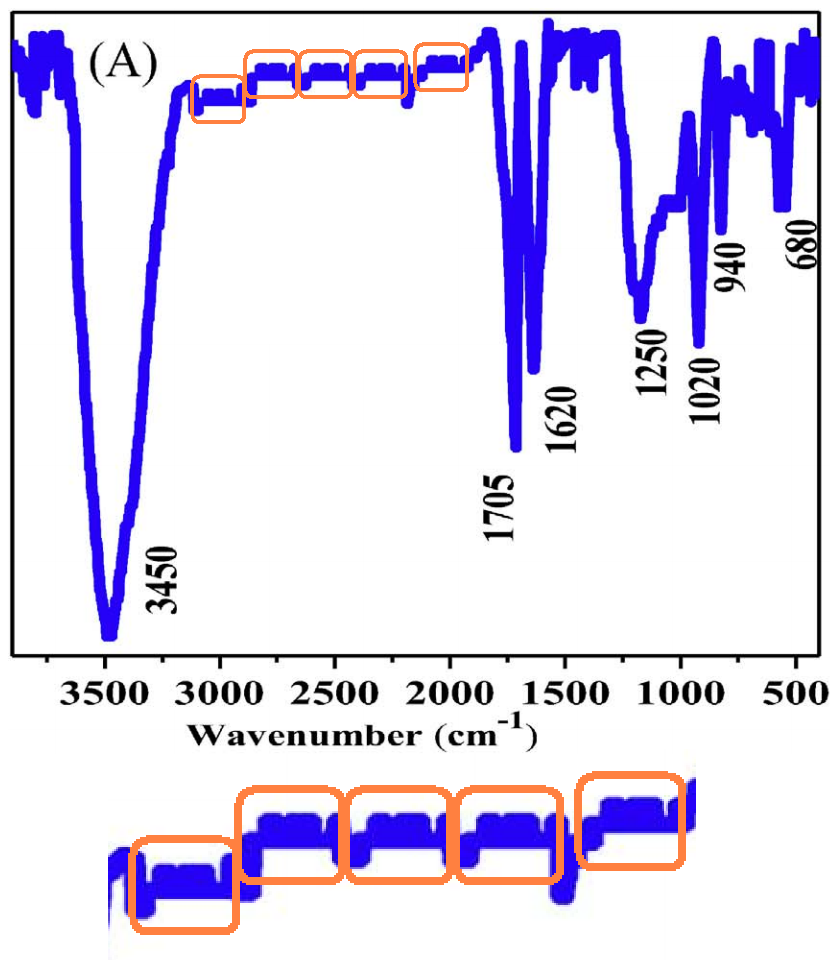 Progressing quickly to a second paper from these authors, its Fig. 1(A) (a FT-IR spectrum for P. catenlannulatus) reveals an unusual repeated feature, rather resembling a front view of a sofa. Somehow it is turning into an airliner seating diagram.
Progressing quickly to a second paper from these authors, its Fig. 1(A) (a FT-IR spectrum for P. catenlannulatus) reveals an unusual repeated feature, rather resembling a front view of a sofa. Somehow it is turning into an airliner seating diagram.
[10] Fengbo Li , Xiaoyu Li , Pu Cui
Detoxification of U(VI) by Paecilomyces catenlannulatus investigated by batch, XANES and EXAFS techniques
Journal of Environmental Radioactivity (2018) doi: 10.1016/j.jenvrad.2018.03.005
The paper also provides a useful segue to EXAFS. To repeat, this is high-end materials science. I would expose the shallowness of my understanding if I tried to explain EXAFS. The crux, though is that at high enough resolution, the fine structure of an X-ray absorption line contains clues to the crystalline neighbourhood of the atoms absorbing those X-rays (because the probability that a photon will dislodge an electron is modulated by the energy-dependent interference between that dislodged electron, as a wave, and neighbouring atoms / bonds). A computation-heavy weighted Fourier transform from the frequency into the spatial domain makes these clues explicit. The only source of sufficiently pure monochromatic X-rays is a synchrotron beam-line, and these are not desktop laboratory devices (though there is one in Shanghai). So not many people are active in the field. Evidently Fengbo Li qualified for access to the Shanghai installation (as well as access to radionuclides), resulting in Figure 6(B) [left], where the bottom profile is an EXAFS spectrum for “U-loaded P. catenlannulatus incubation time = 7 days, pH 4.5, CU(VI) = 20 mg/L.”

Unexpectedly, all three spectra are replotted from counterparts in Fig. 7(B) [right], from
[11] Yubing Sun , Congcong Ding , Wencai Cheng , Xiangke Wang
Simultaneous adsorption and reduction of U(VI) on reduced graphene oxide-supported nanoscale zerovalent iron
Journal of Hazardous Materials (2014) doi: 10.1016/j.jhazmat.2014.08.023
To sum up: we have three small clusters of researchers located around China, repurposing images and results from the large, productive Sun / Wang group. In comments in PubPeer, Sun and Wang have expressed dismay at these acts of intellectual piracy, while preferring not to speculate about exactly how the other groups obtained the Ur-versions. Those clusters are not entirely disjunct: Fengbo Li of the third group was corresponding author on Yao’s paper [6]. Li has also collaborated with Sun, most recently in 2018 (see [12] below). 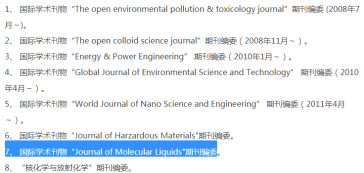 I should note that much of the pirated material was published in the Journal of Molecular Liquids, which benefits from Xiangke Wang‘s presence on its Editorial Board; it is a pity that papers [4], [5], [6], [8] did not cross his desk and alert him to these misdeeds. Perhaps in compensation, there are some unusual patterns of citation (as promised above). In [4], 26 out of 44 references invoke the work of Y. B. Sun. In [5]. 15 out of 44. I am not convinced that they all crucially relevant.
I should note that much of the pirated material was published in the Journal of Molecular Liquids, which benefits from Xiangke Wang‘s presence on its Editorial Board; it is a pity that papers [4], [5], [6], [8] did not cross his desk and alert him to these misdeeds. Perhaps in compensation, there are some unusual patterns of citation (as promised above). In [4], 26 out of 44 references invoke the work of Y. B. Sun. In [5]. 15 out of 44. I am not convinced that they all crucially relevant.
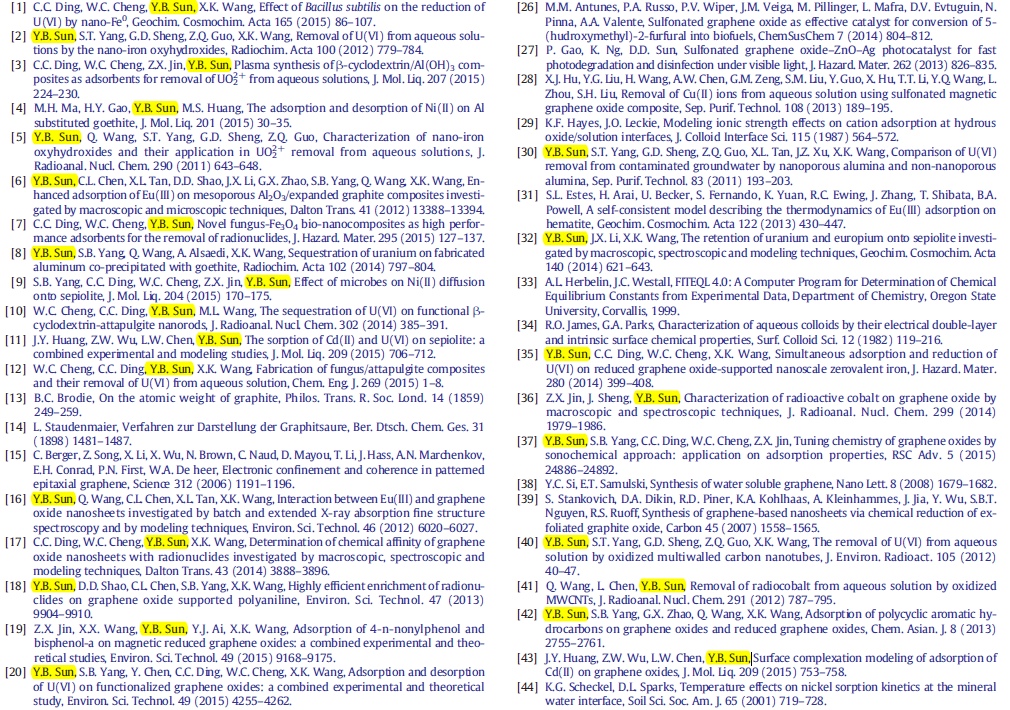

Citations, of course, have become the currency of the academic-publishing economy. Like viewers’ votes in a Reality-TV show, they drive the Impact Factors of journals, and of individual papers, and of course the h-index of individual scientists. Summed across papers, they define the importance and determine the career paths of the authors, removing the need for science administrators to understand anything of what people might have contributed before promoting them or bestowing tenure. Roles on Peer-Reviewer panels and Editorial Boards are determined by citations in all their majestic objectivity. 27 out of 51 references in [6] invoke Y. B Sun. In [8], 27 of 47. This might strike some as immoderate.
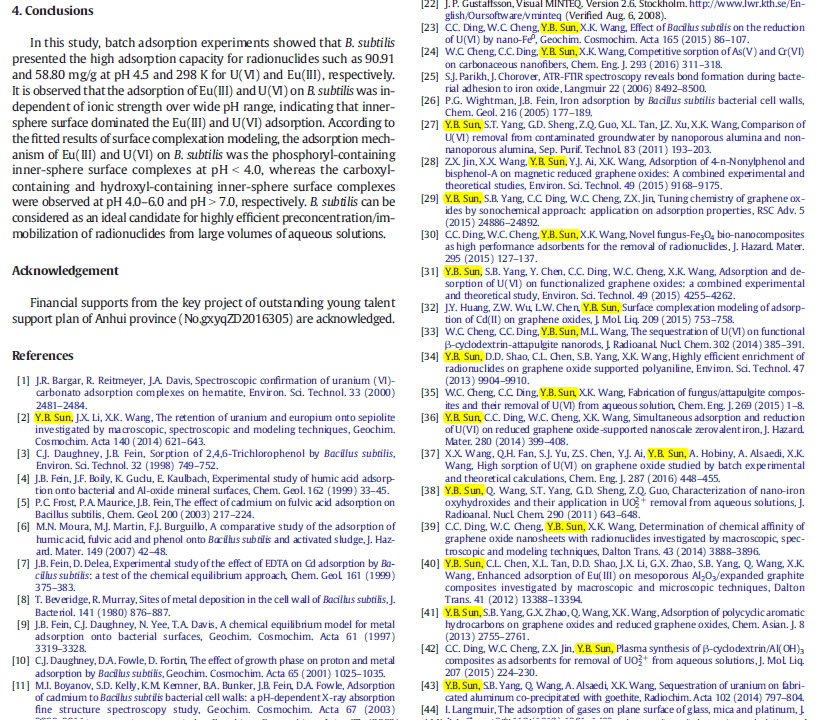
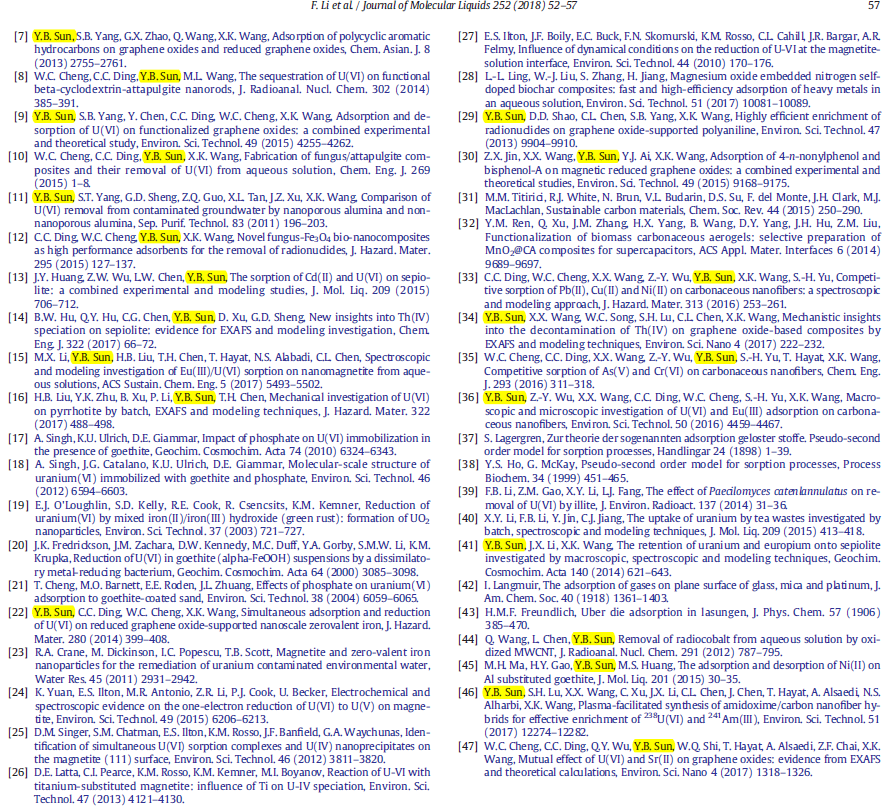
This creates an incentive for authors to pack self-citations into every niche of their own References sections, or as peer-reviewers, to render judgement that a manuscript is unpublishable until it contains 12 citations of one’s own work; though these are generally deprecated. Citation cartels at the level of journals – mutually-beneficial exchanges of backrolling and logscratching between editors – are derogated in the same way. In [10], 23 of 38 citations. In [12], 20 of 56 citations. Here [12] is the Li / Sun collaboration foreshadowed above:
[12] Fengbo Li , Xiaoyu Li , Pu Cui , Yubing Sun
Plasma-grafted amidoxime/metal–organic framework composites for the selective sequestration of U(vi)
Environmental Science: Nano (2018) doi: 10.1039/c8en00583d
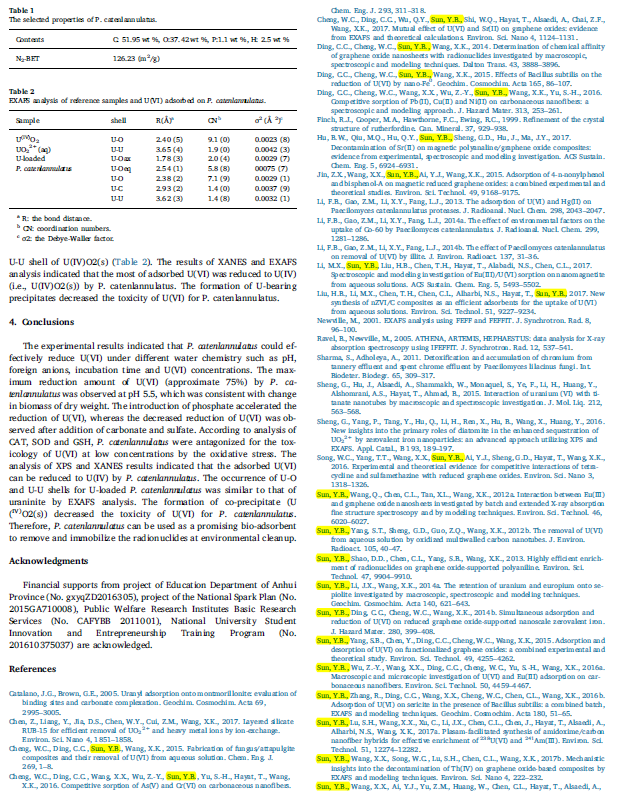
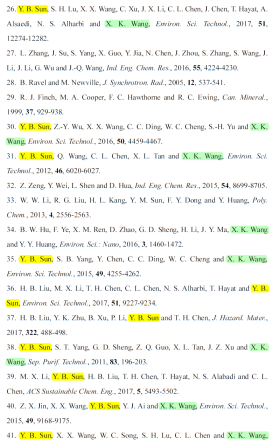
Now [12] commends itself to our attention partly for Figure 1(B), a FT-IR spectrum for an amidoxime/metalorganic framework composite or AO/MOF, containing odd segments of self-similarity.
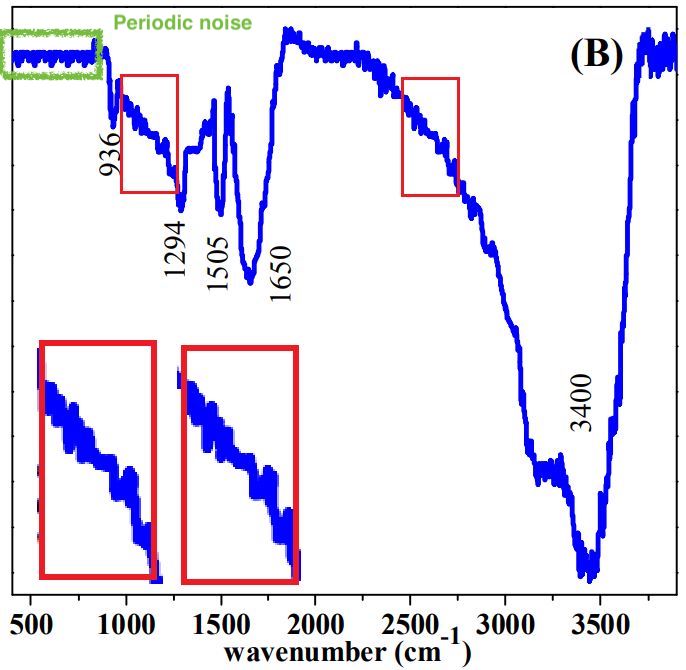

Those features were already present when the spectrum was published a year earlier – vertically compressed – as the upper, red profile in Figure 1(C) of [13]:
[13] Yubing Sun, Songhua Lu, Xiangxue Wang, Chao Xu, Jiaxing Li, Changlun Chen, Jing Chen, Tasawar Hayat, Ahmed Alsaedi, Njud S. Alharbi, Xiangke Wang
Plasma-Facilitated Synthesis of Amidoxime/Carbon Nanofiber Hybrids for Effective Enrichment of 238U(VI) and 241Am(III)
Environmental Science & Technology (2017) doi: 10.1021/acs.est.7b02745
Indeed, the two papers shared any number of results, despite the difference between AO/MOFs and “Amidoxime/Carbon Nanofiber Hybrids”. Xiangke Wang was dismayed by the theft but we have yet to hear from Sun, the author in common.

EXAFS results were shared.

In fact these spectra make a third appearance! They are also Figure 5 [at left] of [14]
[14] Tian Wan , Wen Cheng , Jiehui Ren , Wei Wu , Min Wang , Baowei Hu , Ziyi Jia , Yubing Sun
The influence of nanoscale size on the adsorption–desorption of U(vi) on nano-Al oxides
Environmental Science: Nano (2018) doi: 10.1039/c8en00912k
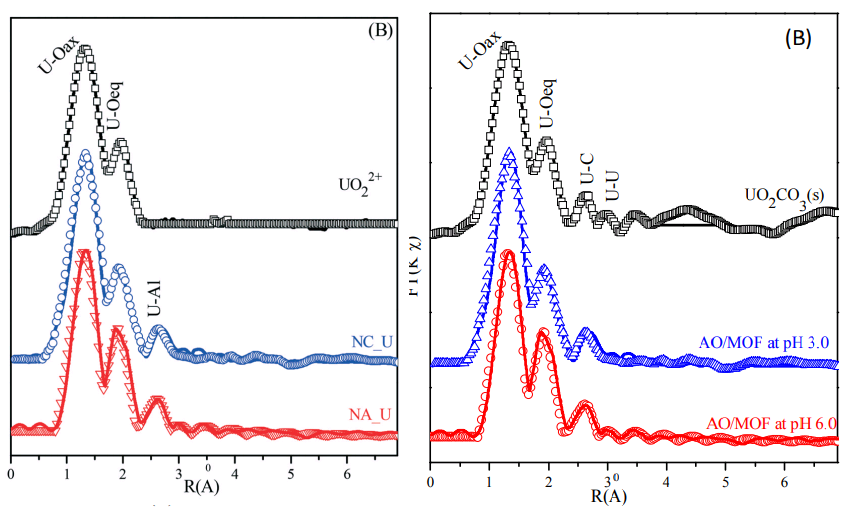
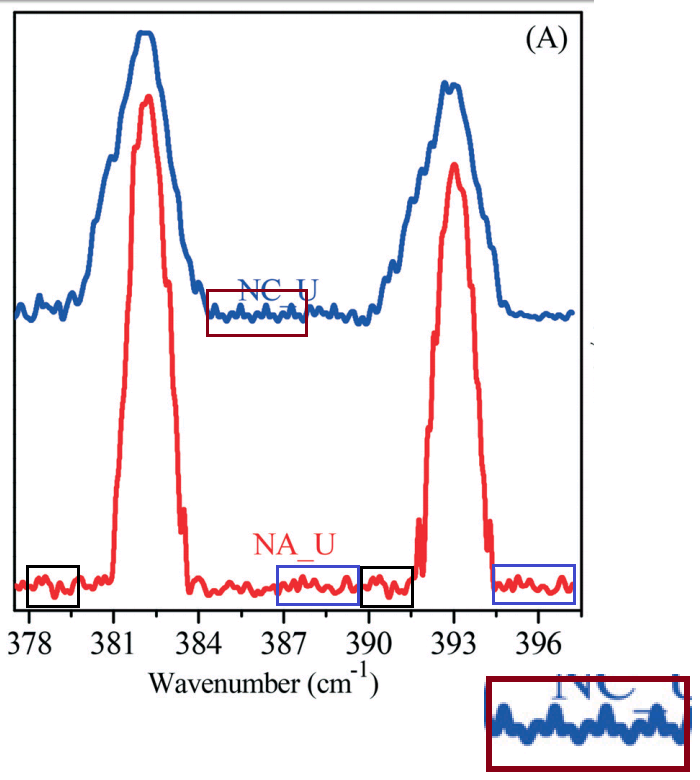 In that third home, two of the spectra donned new identities as uranium-sequestering nano-alumina and nano-corundum. The uppermost spectrum (U(vi) in isolation) is unchanged for R(Å) 2.2 it is flat. The absence of a third peak piqued the curiosity of an EXAFS expert in a Pubpeer comment but the best explanation is that the output was edited. There is just time to admire two Brokenspectrum from [14] before continuing: To the right, some experimental hiccoughs have perturbed Figure 5(A), showing XPS analyses for the two aluminium oxides.We are now within Sun’s canon but there is no space to be exhaustive (readers are invited to explore the relevant PubPeerthreads). I shall quickly select a few representative Brokenspectra.
In that third home, two of the spectra donned new identities as uranium-sequestering nano-alumina and nano-corundum. The uppermost spectrum (U(vi) in isolation) is unchanged for R(Å) 2.2 it is flat. The absence of a third peak piqued the curiosity of an EXAFS expert in a Pubpeer comment but the best explanation is that the output was edited. There is just time to admire two Brokenspectrum from [14] before continuing: To the right, some experimental hiccoughs have perturbed Figure 5(A), showing XPS analyses for the two aluminium oxides.We are now within Sun’s canon but there is no space to be exhaustive (readers are invited to explore the relevant PubPeerthreads). I shall quickly select a few representative Brokenspectra.
[15] Congcong Ding , Wencai Cheng , Yubing Sun , Xiangke Wang
Determination of chemical affinity of graphene oxide nanosheets with radionuclides investigated by macroscopic, spectroscopic and modeling techniques
Dalton Transactions (2014) doi: 10.1039/c3dt52881b
[16] Yubing Sun , Changlun Chen , Dadong Shao , Jiaxing Li , Xiaoli Tan , Guixia Zhao , Shubin Yang , Xiangke Wang
Enhanced adsorption of ionizable aromatic compounds on humic acid-coated carbonaceous adsorbents
RSC Advances (2012) doi: 10.1039/c2ra21713a
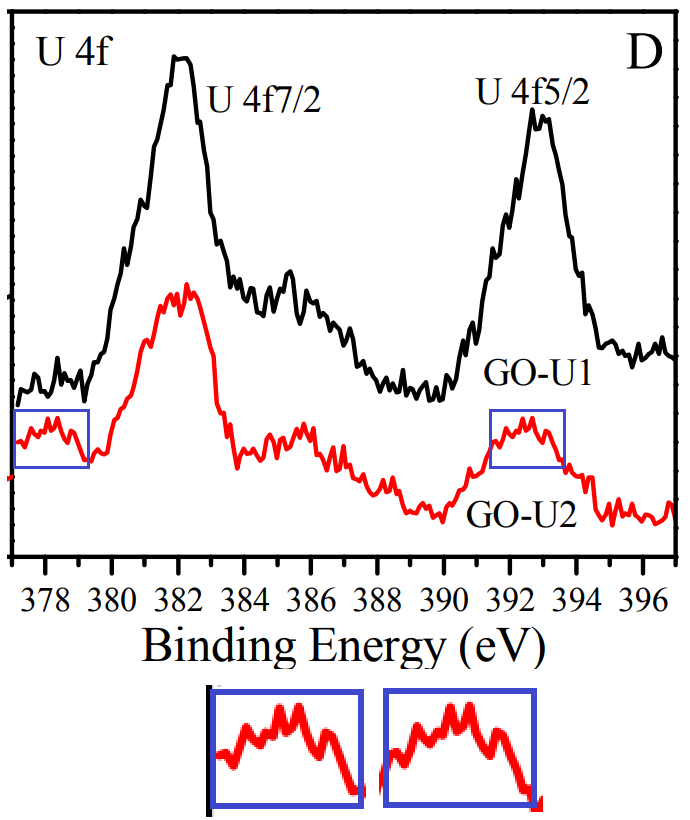
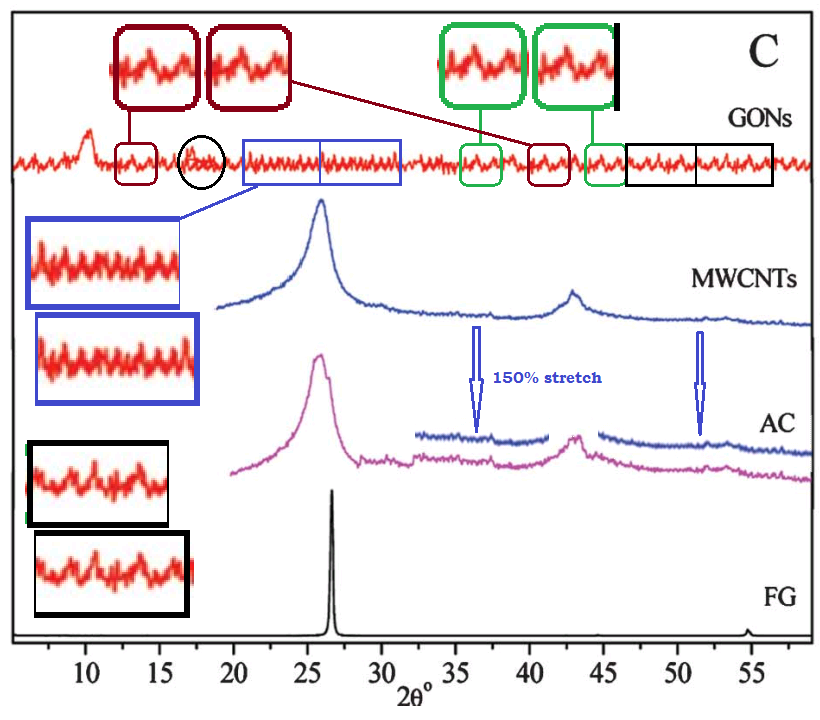
[17] Yubing Sun, Dadong Shao, Changlun Chen, Shubin Yang, Xiangke Wang
Highly efficient enrichment of radionuclides on graphene oxide-supported polyaniline
Environmental Science & Technology (2013) doi: 10.1021/es401174n
[18] Yubing Sun, Xiangxue Wang, Wencheng Song, Songhua Lu, Changlun Chen, Xiangke Wang
Mechanistic insights into the decontamination of Th(iv) on graphene oxide-based composites by EXAFS and modeling techniques
Environmental Science: Nano (2017) doi: 10.1039/c6en00470a

The upper one on the left is really the Prague skyline (right). I really want to concentrate on the EXAFS analyses, for they are the point of difference for this group. So it was natural to take seven raw-data and transformed spectra for functionalized GO, in Figure 4 of [3] [below, left], and compare them against the transformed spectra [right] for “uranium-containing nZVI/C composites” at different pH / time combinations, from [19]. Mirabile dictu, four of them are the same!
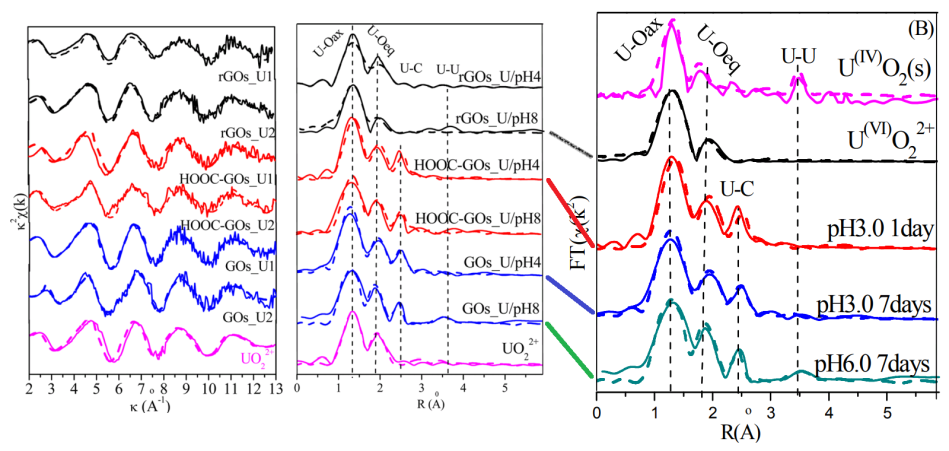
[19] Haibo Liu , Mengxue Li , Tianhu Chen , Changlun Chen , Njud S. Alharbi , Tasawar Hayat , Dong Chen , Qiang Zhang , Yubing Sun
New Synthesis of nZVI/C Composites as an Efficient Adsorbent for the Uptake of U(VI) from Aqueous Solutions
Environmental Science & Technology (2017) doi: 10.1021/acs.est.7b02431
The similarity is not complete, for when the 2015 “rGOs_U/pH8” profile was repurposed to be “U(VI)O22+ in 2017, it was edited to be flat for R(Å) &rt; 2.5.
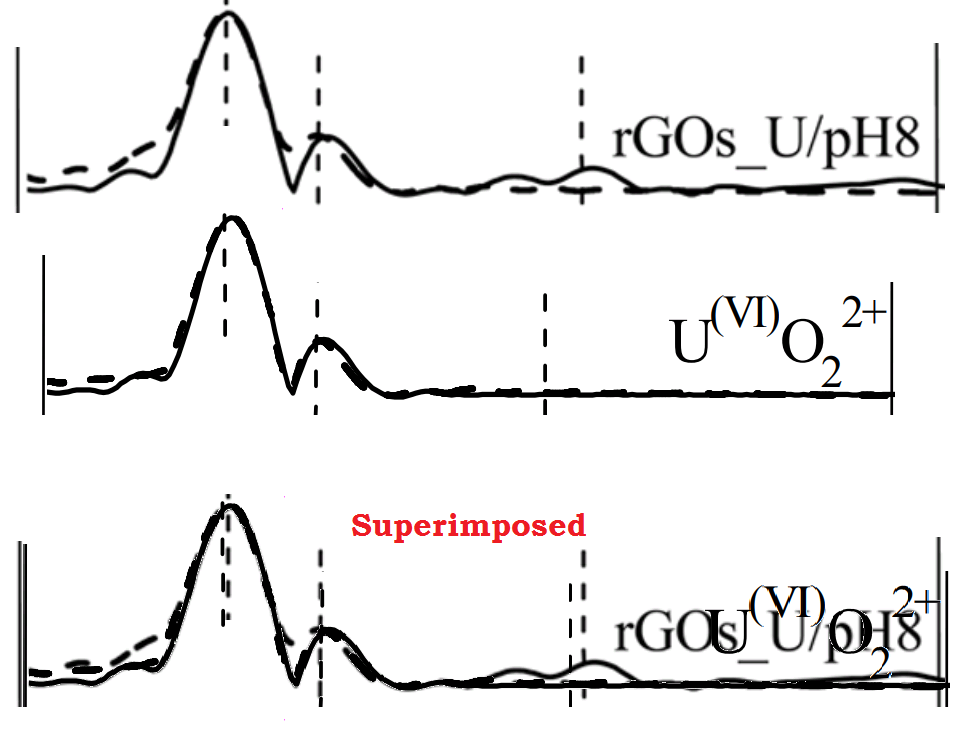
As always, there is more, and I am compelled as if by a gaes to take those seven spectra from [3] and compare them again… four of them also appeared as Fig. 4 in [2], this time representing sonochemically-tuned Uranium-sponge GO variants.
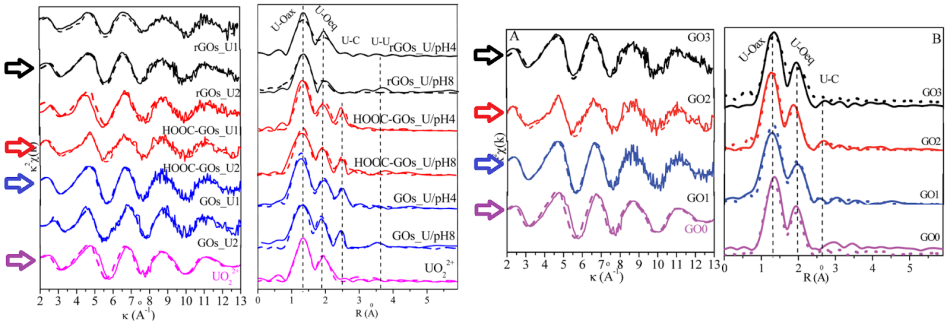
More curious still, although the raw data are the same, the Fourier-transformed versions of these EXAFS spectra do not match. There are only two main humps instead of three, which is like recalculating a camel and ending up with a horse. How does this happen?Now that we are back on the subject of [3], with the functionalized GOs, it may be time to wonder why the FT-IR spectra for GOs and rGOs are identical, down to pixels of noise, except for a 10% horizontal stretch.
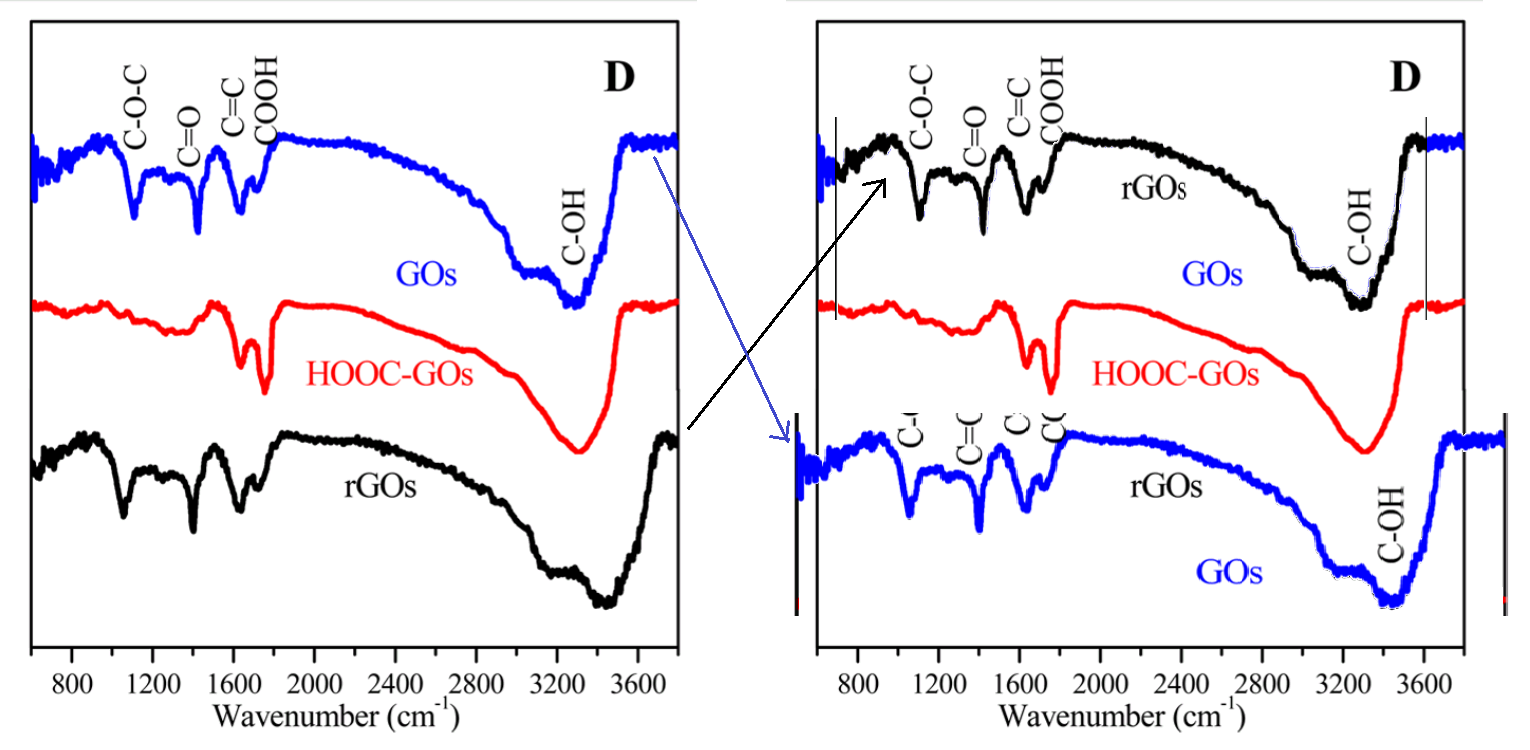
Readers might be worried about Panel 1(C) from [3] – a crumpled paperbag of a reduced-GO sheet, seen via SEM. Don’t worry, it has not been neglected, and was transformed back into GO [here at right] to become Figure 1(A) of [20].
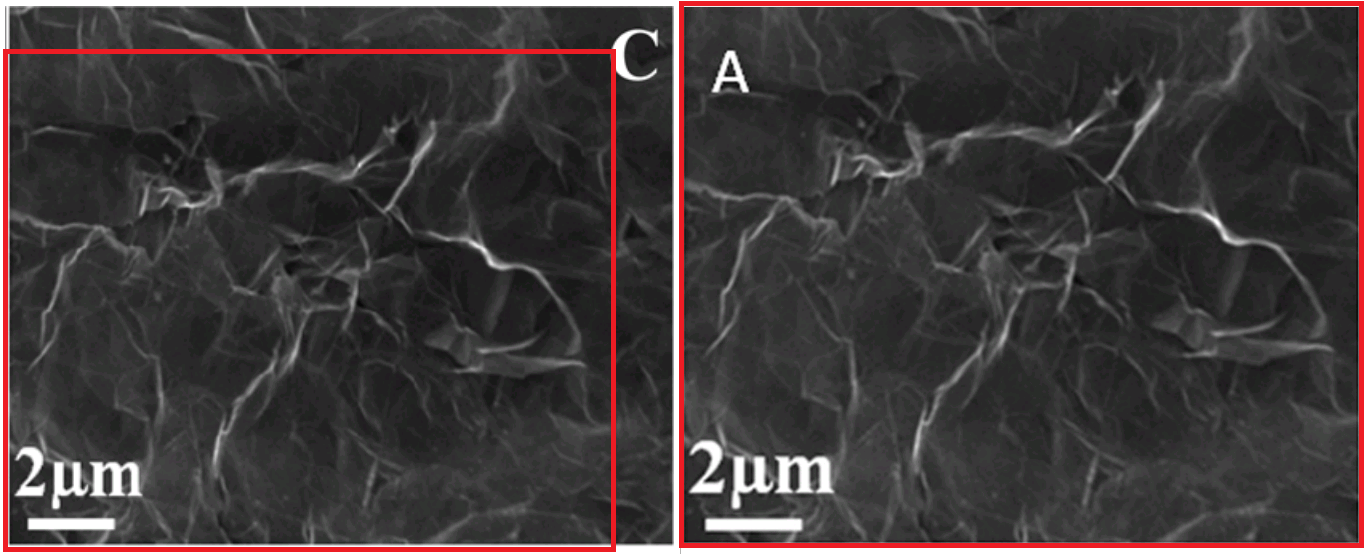
[20] Xiangxue Wang , Qiaohui Fan , Shujun Yu , Zhongshan Chen , Yuejie Ai , Yubing Sun , Aatef Hobiny , Ahmed Alsaedi , Xiangke Wang
High sorption of U(VI) on graphene oxides studied by batch experimental and theoretical calculations
Chemical Engineering Journal (2016) doi: 10.1016/j.cej.2015.11.066
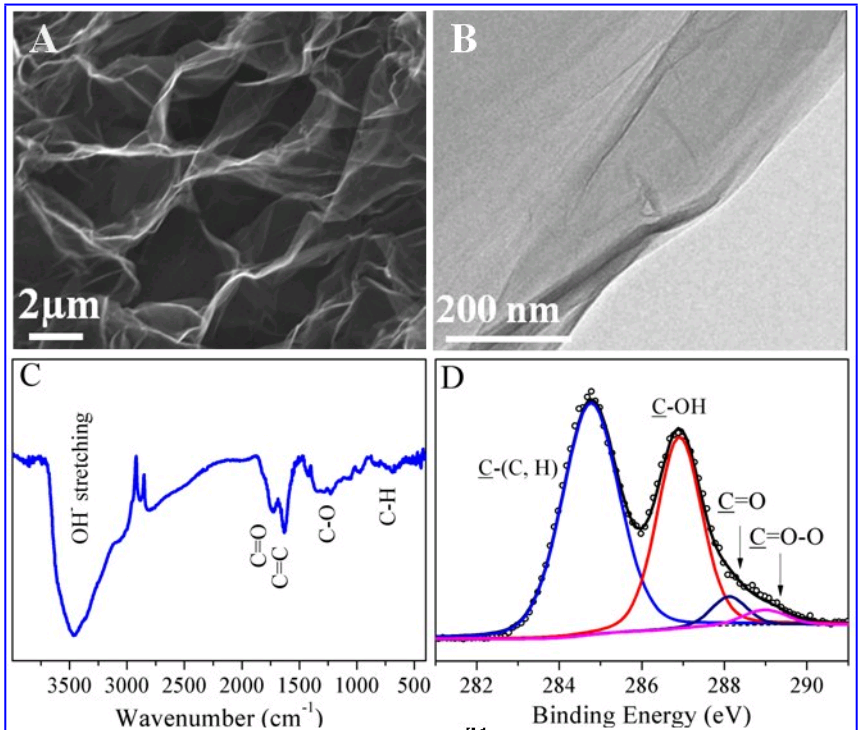 And going back to the Graphene Oxide SEM of [3] Fig 1(A), there are two other reported sightings. One was in Supplementary Figure S1A of [21], which again described the subject matter as GO, so the main concern is that a different microscope had reportedly created the image.
And going back to the Graphene Oxide SEM of [3] Fig 1(A), there are two other reported sightings. One was in Supplementary Figure S1A of [21], which again described the subject matter as GO, so the main concern is that a different microscope had reportedly created the image.
[21] Wencai Cheng, Congcong Ding, Qunyan Wu, Xiangxue Wang, Yubing Sun, Weiqun Shi, Tasawar Hayat, Ahmed Alsaedi, Zhifang Chai, Xiangke Wang
Mutual effect of U(vi) and Sr(ii) on graphene oxides: evidence from EXAFS and theoretical calculations
Environmental Science: Nano (2017) doi: 10.1039/c7en00114b
The second was in Fig. 1D [right] of [22], where in the manner of a master-criminal from sensationalist fiction, the material had changed its identity, and was calling itself a “mesoporous Al2O3/EG composite”.

[22] Yubing Sun, Changlun Chen, Xiaoli Tan, Dadong Shao, Jiaxing Li, Guixia Zhao, Shubin Yang, Qi Wang, Xiangke Wang
Enhanced adsorption of Eu(III) on mesoporous Al2O3/expanded graphite composites investigated by macroscopic and microscopic techniques
Dalton Transactions (2012) doi: 10.1039/c2dt31510f
* * * * * * * * * * * * * * * *
What is one to make of all this? Sun and Wang have reached the pinnacle of Physical Chemistry success, and ascended into the High-Citation empyrean (assisted by a certain degree of self-citation). When you have gained access to (1) exotic materials, and (2) a synchrotron X-ray beamline, with (3) software and (4) grad students to write the manuscripts, then a stream of publishable papers is guaranteed (along with the funding to ensure that (1)-(4) continue). There should be no need to manipulate spectra, and duplicate results, and extract different, incompatible spectra from single sets of data. In particular, there should be no need for groups of outsiders to this niche of materials science, embellishing their academic records with papers consisting of images from Sun & Wang, text in the style of Sun & Wang, and citations to Sun & Wang. One’s papers (and the broader plot arcs they build) should already be attracting citations from other researchers in the field. Assuming, of course, that other researchers in the field can replicate one’s results and calculations. [Thanks TigerBB8 for contributions]

Donate!
If you are interested to support my work, you can leave here a small tip of $5. Or several of small tips, just increase the amount as you like (2x=€10; 5x=€25). Your generous patronage of my journalism will be most appreciated!
€5.00

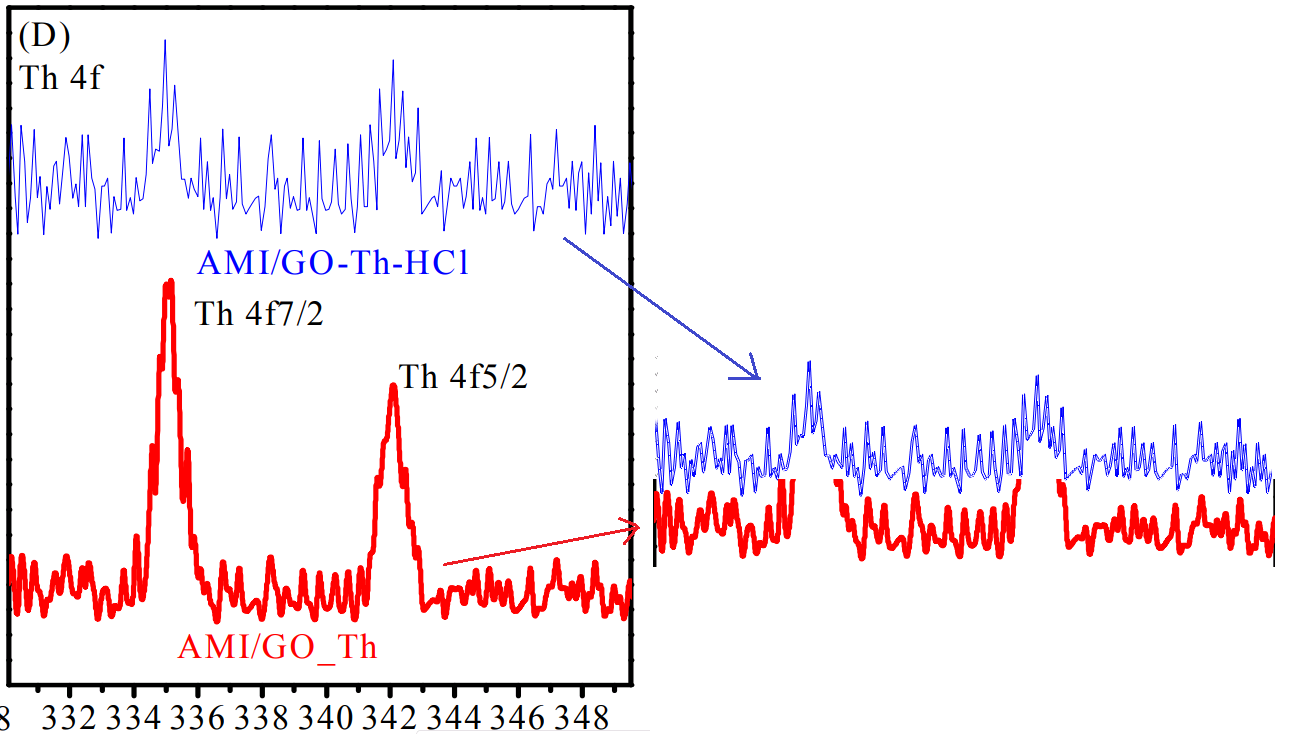


I’m speechless and exhausted.
Great work and very interesting with a new dimention of fraud.
Why do serious researchers support these journals by publishing there? There is a total lack of quality control and the publishers and editors do not show any responsibility.
This is a general problem and of course driven by commercial interests. Societies like AACR and ACS and publishers like Elsevier and MDPI have only one interest: profit. They give a damn about the science. Pubpeer is full of obvious data manipulations and falsifications, but they are hardly addressed at all.
Research institutes should stop using the commercial publishers and start their own journals in collaboration with each other.
Smut Clyde: Did you send your full report to the editors and the mentioned research institutes?
LikeLiked by 1 person
I’m speechless and exhausted.
Having read too much Thomas Mann as an impressionable youth, I subscribe to his maxim that “Only the exhaustive can be truly interesting”.
Did you send your full report to the editors and the mentioned research institutes?
I do not know the appropriate contact addresses.
spanning 22 papers
In fact 24… the first two images have links to PB threads, but I didn’t count them, because I couldn’t be bothered renumbering the whole series.
LikeLike
Fabrications creep into other papers from X.-K. Wang’s group that do not include him or Sun as actual authors.

https://pubpeer.com/publications/139E0A31CC4565ACB5BFA9989B6C18
LikeLike
Wang’s student / collaborator Congcong Ding, with an image of a novel uranium-accumulating fungus “Streptomyces sporoverrucosus dwc-3″:
https://pubpeer.com/publications/011A9EC3C93AB6C0EF724690397518
… previously published as penicillium.
https://pubpeer.com/publications/9ACAE043116EEA9DED9E634E0A963E
Truly the student has learned well.
LikeLike
Congcong Ding was a student of Wang, co-supervised by Sun
LikeLike
ah, here is that same group of Team Wang authors, reusing and modifying the already-retouched 2015 data for a 2017 paper about a different material.
https://pubpeer.com/publications/08FAF5E31419399B3F750A9AC69D93
LikeLike
3 of the 4 authors, Wencai Cheng , Zhongxiu Jin , Congcong Ding, all were grad students of Wang and co-supervised by Sun.
LikeLike
Incredible examples of most stupid fakes one could only imagine. Isn’t it scary that incompetent fraudsters have an access to radioactive materials? They sell their reputation so cheap for few personal benefits. What if they sell also their radioactive materials to wrong hands? If they are so lazy in faking spectra, can they take proper care of dangerous chemicals?
LikeLike
Perhaps the fraud should reassure us on @Challenger’s worry regarding safety: it may well be they never go their hands (or rather gloves) dirty, and photoshop did all the heavy work.
LikeLike
Some of the data was allegedly generated at the Shanghai Synchrotron Radiation Facility
There seem to be at least two synchrotron installations in China, with the Shanghai one (SSRF) being newer and more powerful than the National Synchrotron Radiation Facility.
A 2009 paper (https://pubpeer.com/publications/99363A98795CE257F0B9DE2EDD9CC8) credits the NSRF:
“Eu LIII-edge X-ray absorption spectra at 6976.9 eV were recorded at the National Synchrotron Radiation Laboratory (NSRL, China).”
By 2012 (https://pubpeer.com/publications/9738050222570F828E758056AE908B), Team Wang had access to the SSRF: “Eu(III) LIII-edge EXAFS spectra at 6976.9 eV were recorded at room temperature at Shanghai Synchrotron Radiation Facility (SSRF, China)”.
Reassuringly, the two sets of raw spectral measurements and the Fourier-transformed version of those measurements (for three reference / calibration samples) are slightly different, as should be the case:
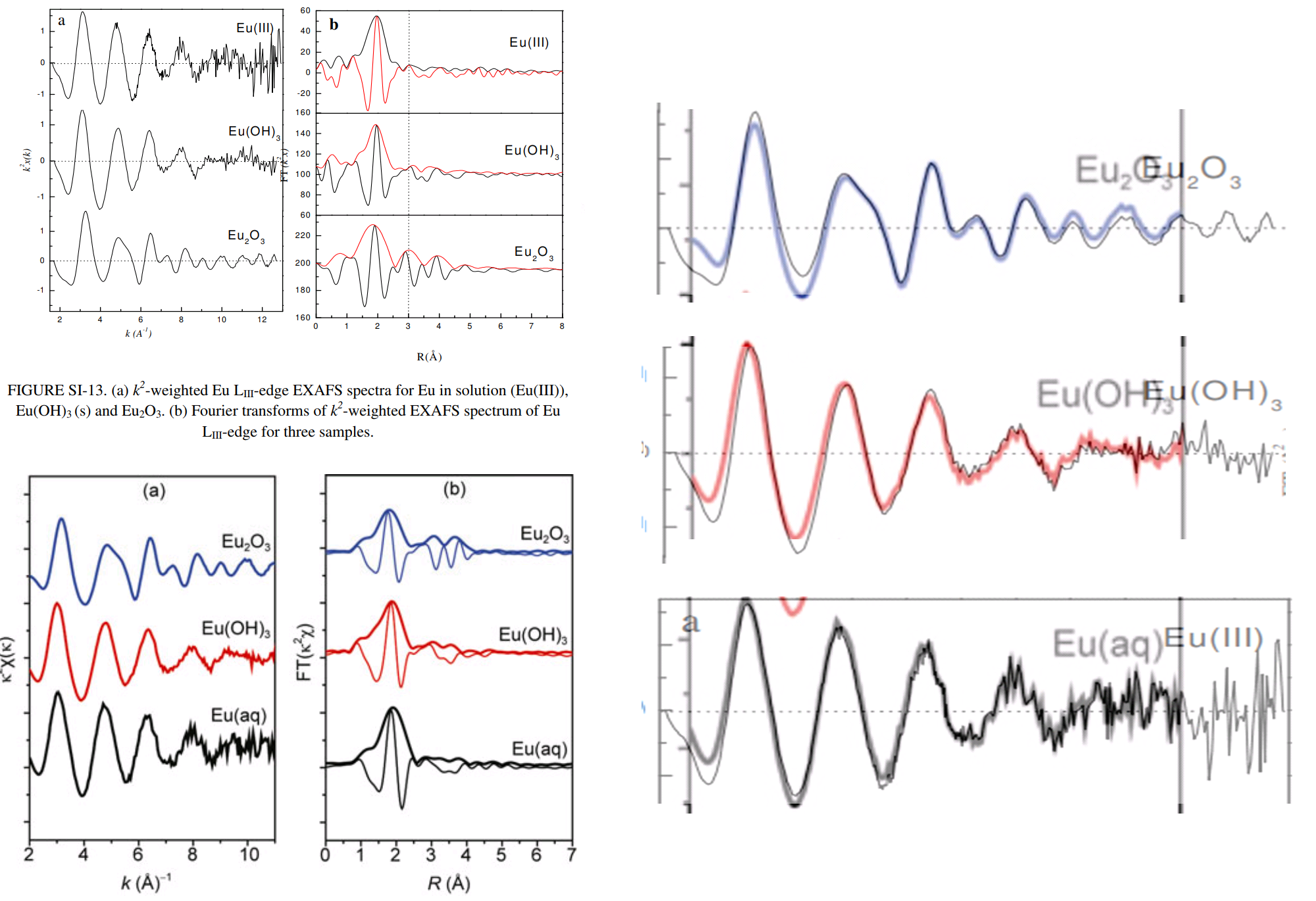
Weirdly, though, the high-frequency jitters of noise in the raw data (the papers describe them as noise, anyway) are exactly replicated. It may be that I misunderstood something and the jitters are really part of the signal.
It is for experts in the field to say whether they’re having problems replicating results from the SSRF from other groups.
LikeLike
I don’t know, I think these materials are ready for testing on humans. Three guesses who the first volunteer subjects should be. It would be a sort of natural justice.
LikeLike
Congcong Ding was a PhD student studied under Xiangke Wang and co-advised by Yubing Sun. Her 2016 PhD thesis from University of Science and Technology in China listed 16 publications. 8 of them have been flagged on Pubpeer. Included in her thesis was a declaration of original work (last picture), signed by her and her advisor Wang.





LikeLiked by 1 person
Talking of shady Chinese science, what do you make of this TCM paper- https://pubs.rsc.org/en/Content/ArticleLanding/2018/TB/C8TB00068A#!divAbstract?
Published in an RSC journal, it talks of the effect of Qi on nano-Au.
LikeLike
That journal was captured by the Chinese some time ago to serve as an outlet for their nano-garbage. The paper mentioned is a good example. They make considerable mention of surface plasmon resonance properties of medicines, but never actually measure any. They simply do UV spectroscopy showing the usual fake curve sets. This is not so much science as sympathetic magic.
LikeLike
Shame on them and good job, For Better Science.
LikeLike
Even if the date in those papers were real, those papers appear to me like worthless repetitions of some pointless exercise. There is no problem solved, just characterization of some dirt materials. They could do the same experiments with carbonized cow-dung instead of graphene oxide, the results would be similar. Unfortunately, since journals are no longer printed in paper, digital space costs nothing and thus journals don’t mind to accept as many manuscripts as they can get. The more papers on similar topics and from the same authors, the more self-citations, the higher the journal impact factor.
LikeLike
Sorry folks, I thought I hade made up the wording “carbonized cow-dung” on the spot, but if you enter it into google, you will find “Carbonized cow dung as a high performance and low cost anode material for bioelectrochemical systems” or “Cow dung-derived nitrogen-doped carbon as a cost effective, high activity, oxygen reduction electrocatalyst” and other papers. Others call it “carbonized cow-manure”. Maybe Yubing Sun might want to try those materials for real, I guess he already has the spectra measured.
LikeLike
I looked at the second on your list, and what a surprise, there are lengths of what one might charitably call “replicated noise”/
LikeLike
A couple of people in China translated this post in Chinese and posted here: https://zhuanlan.zhihu.com/p/61066127
Also, Sun’s university initiated an investigation, based on a note shared internally. Here is a screenshot of the note:
LikeLike
Chinese News Agency The Paper reported this case yesterday (Apr 14) based on an interview with the translators of this guest post by Smut. Reporters from The Paper reached out to the North China Electric Power University and the university representative confirmed that a formal investigation has been launched to look into Sun’s alleged misconduct. The Paper is a relatively new news agency quite popular in young generation and has a reputation somehow much credible than the big official ones such as CCTV.
For non-Chinese readers, Google translate might not be that bad for reading this news piece.
https://www.thepaper.cn/newsDetail_forward_3294610
LikeLike
Forgot to say, great job Smut and Leonid (and a tiny little bit of me…….🤓)
LikeLike
A news update has been provided by The Paper today. Two other universities whose faculty were alleged to participate in Sun’s paper fraud have responded to The Paper reporter that they are looking into their faculty’s role in this case. These two universities are: Xiamen University of Technology (where Min Pan and Xiaoming Huang are working) and Huangshan University where Fengbo Li works.
https://www.thepaper.cn/newsDetail_forward_3298258
LikeLike
Any news from China about this story?
Authors published set of bizarre corrections simply stating that some error is found and replacing one spectrum with another one. Like that one for example:
https://pubs.acs.org/doi/10.1021/acssuschemeng.9b01880 Note different frequency of noise in the two shown spectra collected supposedly using the same equipment with the same settings.
No explanation to ” the odd repetition of background” is given in another one:
https://link.springer.com/article/10.1007%2Fs10967-019-06538-1
LikeLike
Or “Adsorption of polycyclic aromatic hydrocarbons on graphene oxides and reduced graphene oxides”.
https://pubpeer.com/publications/8031ADC2840272A888A77446A6DC94
Before:
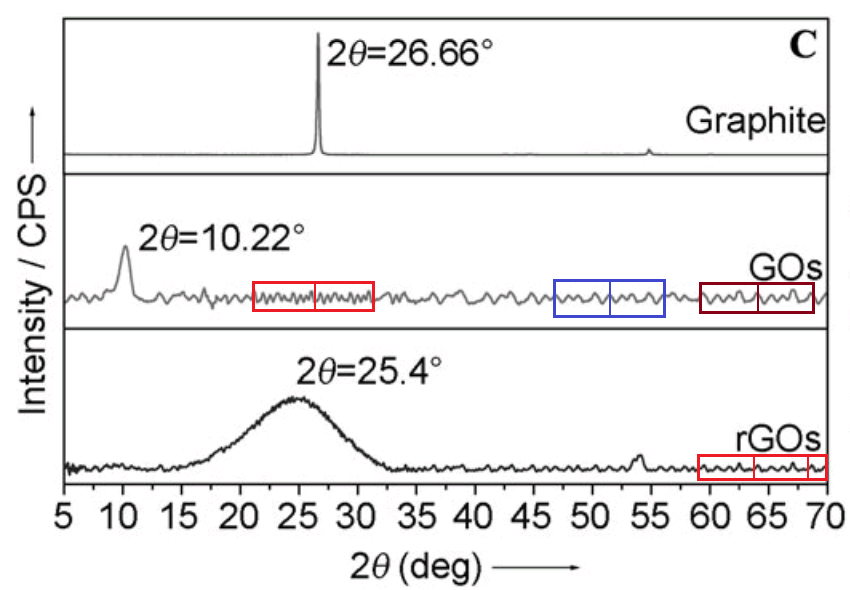
After:

It’s as if Wiley, and the editors of “Chemistry – An Asian Journal”, don’t really care.
LikeLike
A recent correction from Xiangke Wang’s group: “The Figure 2(a, b) in the original paper is in error, which results in the TEM and SEM images of GO have a big difference with the description. ”
H/t Thallarcha Lechrioleuca.
The erratum hints at the re-use of one image from another paper (involving different materials), while ignoring a second recycled image.
https://pubpeer.com/publications/51BF9A00606044E23CC398A3C3C3AF
https://pubpeer.com/storage/image-1569773033980.jpg
https://pubpeer.com/storage/image-1569773641045.jpg
LikeLike
Pingback: Real rats tortured for fake neuroscience – For Better Science
Xiangke Wang of North China Electrical Power University has been showing up lately in PubPeer threads without Yubing Sun. Jie Li is a frequent co-author on this latest harvest.
“Reductive immobilization of Re(VII) by graphene modified nanoscale zero-valent iron particles using a plasma technique”…
https://pubpeer.com/storage/image-1570741495653.jpg
https://pubpeer.com/storage/image-1570837336053.png
https://pubpeer.com/storage/image-1570836842867.png
LikeLike
“Nanoscale zero-valent iron particles supported on reduced graphene oxides by using a plasma technique and their application for removal of heavy-metal ions”…
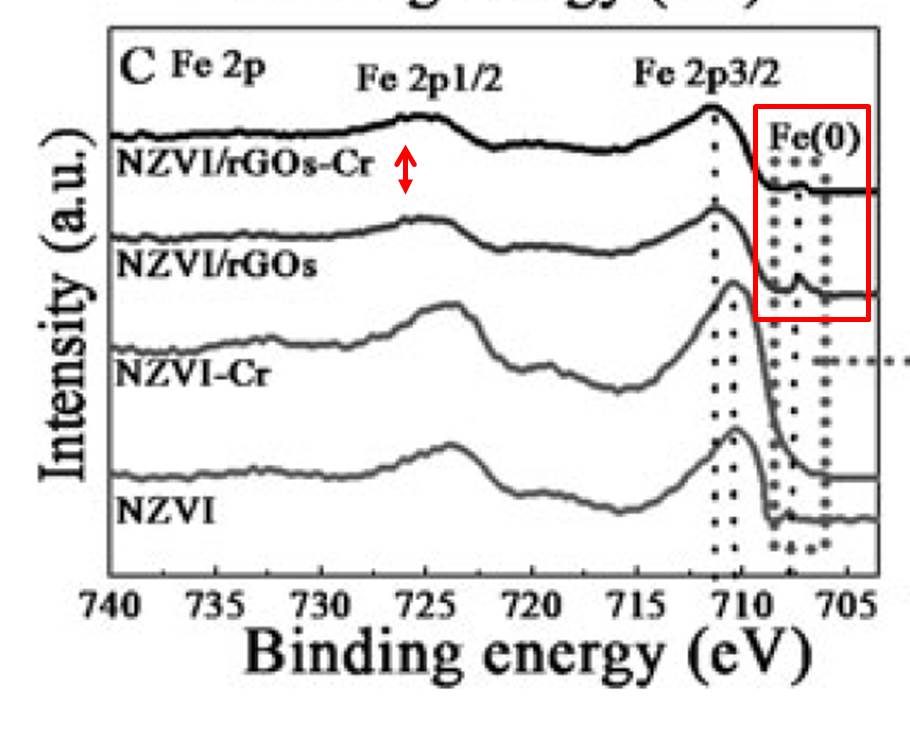
“Magnetic polydopamine decorated with Mg–Al LDH nanoflakes as a novel bio-based adsorbent for simultaneous removal of potentially toxic metals and anionic dyes”…

LikeLike
“Plasma-induced grafting of polyacrylamide on graphene oxide nanosheets for simultaneous removal of radionuclides” – https://pubpeer.com/publications/8D34FDDB7CD1075A5F97DC1AFE3B63
Xiangke Wang came to the defense of the paper, pointing out that he had the original Raman-shift measurements open as a spreadsheet, and the difference between the two spectra (4th column below) is not constant, therefore the measurements are not faked.
” I checked the data in order to check what is the main problem. For other data, the data differences are different. This is really the original data and I really do not know the reason. such as the following:”
It did not end well.
LikeLike
I shared your findings on China’s Weibo (a Chinese copycat of Twitter) regarding the consistent difference (yeah, different by a constant) of the spectrum data posted by Xiangke Wang. In a couple of hours, my post was prohibited from being reposted (similar to a re-tweet on twitter) by my followers. Looks like after a couple of retractions of Yubing Sun’s papers, they are trying very hard to cover up for this Xiangke Wang. However, this paper’s fabrication, together with 20 other papers flagged on Pubpeer, cannot be Yubing Sun’s fault because he was not even a co-author on these papers.
LikeLike
This guy was sure that nobody will ever take the job to look at numbers. Good job to expose this Smut Clyde! Xiangke Wang is highly cited researcher recognized with special awards:
https://english.ncepu.edu.cn/hddt/47735.html
“Only 13 Chinese scientists receive global Highly Cited Researchers Awards in two fields at the same time.” How many citations now need to be subtracted from the record?
LikeLike
Pingback: Fake spectra googling #CleanYourScience – For Better Science